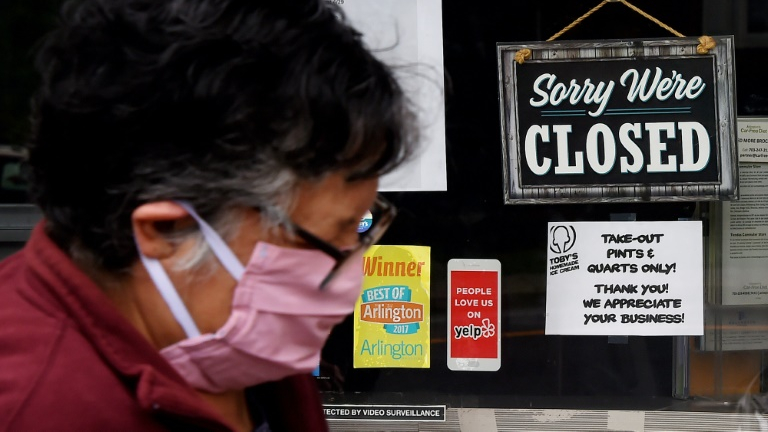
File photo: CGTN
Initial jobless claims totaled 1.508 million last week, marking the 13th consecutive week the number has stayed above 1 million, the US Labor Department reported Thursday.
Economists surveyed by Dow Jones expected 1.3 million new claims to be filed for the week ended June 13.
Despite the historically high number of workers filing unemployment claims, applications are down significantly since the peak in March, suggesting the economy and labor market are recovering from disruptions caused by the coronavirus pandemic.
The number of new applications dipped by 58,000. That's the fewest number of initial jobless claims filed since mid-March, but it also showed the pace of job loss hasn't dropped significantly.
Continuing claims, or those who have received unemployment benefits for at least two weeks, fell 62,000 from the previous week to 20.5 million, the Labor Department said.
The four-week moving average was 20.814 million, down 1.092 million.
The US unemployment rate fell to 13.3 percent in May from 14.7 percent in April.
In May, nonfarm payrolls increased by 2.5 million as states across the nation began to reopen the economy. Retail sales, or sales at stores, online and restaurants, increased 17.7 percent from April, the Commerce Department reported.
Consumer spending represents about two-thirds of the US economy.
A New York analyst offered a less sanguine view of the recovery.
"People will say claims are coming down, but for an economy that's reopening, that's a huge number," Steven Blitz, chief US economist at TS Lombard in New York, told Reuters. "The economy is losing workers and employment beyond the initial impact tied to businesses that shut down. There are a lot of industries that are getting hurt and that's starting to cascade down, that is what the numbers are showing."
On Tuesday, Federal Reserve Chairman Jerome Powell said the economy won't recover until the public is certain the coronavirus has been contained.
Retail, manufacturing, information technology and energy production companies have announced job cuts. Some state and local governments, whose tax revenue has been reduced by the COVID-19 pandemic, have also reduced employment.
But the price of oil, a proxy for future economic activity, has rebounded from its low as investors bet on increased demand ahead.
In addition to standard applications for unemployment benefits, there were 760,526 claims filed under the Pandemic Unemployment Assistance Program. The total marked a decrease of 375,522 from the previous week.
That boosted the number receiving the benefits to 29.1 million through May 30, the data available.
The Coronavirus Aid, Relief, and Economic Security Act (CARES) provides up to 39 weeks of unemployment benefits to individuals not eligible to receive regular unemployment compensation or extended benefits, including those who have exhausted the benefits.
The CARES Act is intended to help the self-employed, including independent contractors, gig workers and others who don't qualify for unemployment benefits. These workers aren't usually tracked in government figures.
The COVID-19-induced economic disruption has made it difficult for many to pay their bills.
The percentage of renters participating in "acute relief" programs in March and April increased 25 percent in aftermath of the coronavirus pandemic, said TransUnion, a Chicago-based consumer credit reporting agency.
"Forbearance and deferment programs have given renters a leg-up during this unexpected economic downturn, and it appears many renters have reduced their immediate debt obligations in the near-term," Maitri Johnson, vice-president of TransUnion's tenant and employment department, said in a statement.
The program permits consumers to suspend payments with a lender to increase financial flexibility during the downturn.
The stimulus package signed into law in March permitted borrowers to skip student loan payments through September.
The number of student loans in deferment increased to 79 million from 18 million in May while the number of auto loans in deferment about doubled to 7.3 million accounts. The number of personal loans in the same category doubled to 1.3 million, TransUnion said.
TransUnion said credit card utilization rates continue to decline, suggesting many are cutting back rather than taking on new debt to meet routine expenses. At the end of 2019, the average renter used 45.3 percent of available credit lines. At the end of April, the utilization rate fell to 39.8, a decline of 12.14 percent.
"The presence of federal stimulus package have offered temporary relief for many consumers, but it is yet to be determined if this is merely postponing payment risk increases," the credit reporting agency said.


